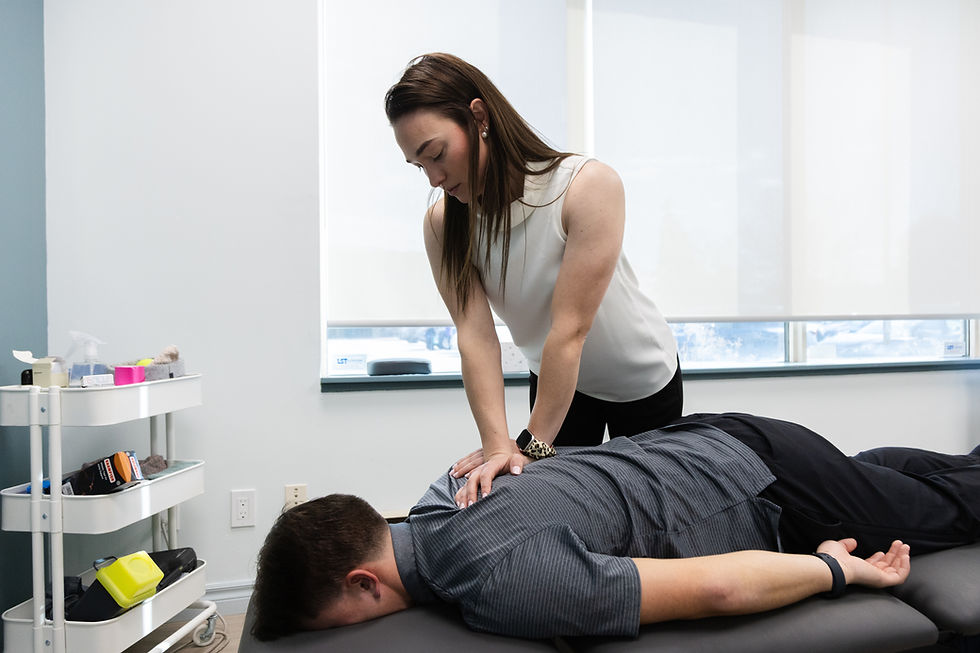Why Active Release Technique (ART) Is a Game-Changer for Fascial Mobility in Golfers
- Kaitlyn Jolivet

- Oct 27
- 3 min read

Golf might seem like a low-impact sport, but anyone who’s played regularly knows the toll it can take on the body—especially on the muscles that power each swing. Among the most common, yet overlooked contributors to golf-related tightness, discomfort, and performance limitations, is fascial restriction. This is where Active Release Technique (ART) comes into play as a highly effective method for restoring fascial mobility, improving biomechanics, and helping golfers play better and recover faster.
What Is Fascial Mobility—and Why Does It Matter in Golf?
Fascia is a web of connective tissue that wraps around muscles, nerves, and organs. Think of it as
the body’s internal support network. When fascia is healthy, it’s flexible and allows muscles and joints to glide smoothly. But repetitive movements—like a golf swing—can lead to fascial adhesions and restrictions, reducing mobility and leading to compensatory movements, pain, or even injury.
In golfers, common areas of fascial restriction include:
Thoracic spine and shoulders (affecting rotation and club position in the backswing and follow through)
Hips and pelvis (impacting rotational power, balance, pressure shift & creating separation)
Forearms and wrists (critical for grip strength and club control)

Enter Active Release Technique (ART)
ART is a hands-on soft tissue therapy technique designed to identify and treat adhesions/restrictions within muscles, tendons, ligaments, and fascia. It involves the practitioner using their hands to apply precise tension while guiding the patient through specific active movements. This breaks up adhesions and restores normal tissue function to improve flexibility and mobility to the targeted area.
How ART Benefits Fascial Mobility in Golfers

Restores Full Range of Motion
Restricted fascia limits flexibility, rotational separation and power in a golf swing. ART targets
those restrictions, freeing up movement in key joints such as the hips, shoulders, and spine. Improved fascial glide means smoother, more powerful swings and a reduced risk of injury. Restoring full range of motion prevents compensation and allows you to achieve positions in the swing you want to get into.
Improves Swing Mechanics
A restricted thoracic spine or restricted shoulder mobility can throw off swing mechanics and
cause an “all arms” swing. ART helps correct these imbalances, enabling better posture, rotation, and pressure shift by creating proper sequencing. This not only improves performance but reduces the chance of developing compensatory injuries.
Enhances Muscle Efficiency
When fascia is stuck, muscles must work harder to move through ranges of motion. ART
releases these restrictions, allowing muscles to contract more efficiently and recover faster. That
means less fatigue during play and more consistent performance throughout a round.
Reduces Risk of Overuse Injuries
Golfers are prone to repetitive strain injuries like golfer’s elbow, shoulder impingement, or low
back pain. ART addresses the underlying fascial restrictions that contribute to these injuries, promoting long-term joint and muscle health. Allowing proper use of larger muscles throughout a golf swing alleviates pressure on the smaller muscles, so restoring fascial mobility prevents the small muscles from overworking.
Accelerates Recovery
After long rounds or intensive practice, fascial tightness can build up and linger. ART can be used as a recovery tool to flush out adhesions, improve circulation, and decrease post-round soreness.

What Golfers Say
Many professional golfers integrate ART into their regular recovery and performance routines. The ability to move better and with less pain is often the difference between a good swing and a great one. Even amateur players report increased flexibility, reduced stiffness, and better overall swing mechanics after incorporating ART into their maintenance plan.
Final Thoughts
In a sport that demands precision, fluidity, and rotational power, fascial mobility is not optional—it’s essential. Active Release Technique offers a powerful, evidence-based solution for golfers looking to improve movement quality, reduce pain, and enhance performance. Whether you’re an elite competitor or a weekend enthusiast, ART could be the key to unlocking your full potential on the course.
Your fascia shouldn’t hold you back. With ART, you can move freely, swing effortlessly, and play your best golf—pain-free.




Comments